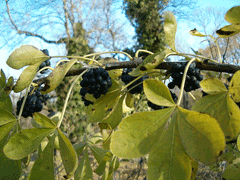 |
|
http://commons.wikimedia.org/wiki/User:BotBln |
 |
|
Translate this page:
Summary
Physical Characteristics

 Eleutherococcus gracylistylus is a deciduous Shrub growing to 3 m (9ft 10in).
Eleutherococcus gracylistylus is a deciduous Shrub growing to 3 m (9ft 10in).
See above for USDA hardiness. It is hardy to UK zone 6. It is in flower in August. The species is hermaphrodite (has both male and female organs).
Suitable for: light (sandy), medium (loamy) and heavy (clay) soils and can grow in nutritionally poor soil. Suitable pH: mildly acid, neutral and basic (mildly alkaline) soils. It can grow in semi-shade (light woodland) or no shade. It prefers moist soil. It can tolerate atmospheric pollution.
UK Hardiness Map
US Hardiness Map
Synonyms
Acanthopanax gracylistylus. W.W.Sm.
Plant Habitats
Woodland Garden Sunny Edge; Dappled Shade; Shady Edge;
Edible Uses
Edible Parts: Flowers
Edible Uses:
Flowers[177]. No more details are given.
References More on Edible Uses
Medicinal Uses
Plants For A Future can not take any responsibility for any adverse effects from the use of plants. Always seek advice from a professional before using a plant medicinally.
Antibacterial Antirheumatic Diuretic Miscellany
The leafy shoots are tonic and are also believed to alleviate internal injuries by dispelling blood[218]. The root bark is antibacterial, antirheumatic and diuretic[176]. It is used in the treatment of arthritis, backache and a host of other ailments. A medicinal wine made from it is commonly on sale in China[218]. A decoction of the stem bark or the roots is used in the treatment of rheumatoid arthritis, aches and pains in the back and legs, open sores on the scrotum, beriberi and traumatic injuries[147]. The plant is aphrodisiac, nutritive and tonic[218].
References More on Medicinal Uses
The Bookshop: Edible Plant Books
Our Latest books on Perennial Plants For Food Forests and Permaculture Gardens in paperback or digital formats.

Edible Tropical Plants
Food Forest Plants for Hotter Conditions: 250+ Plants For Tropical Food Forests & Permaculture Gardens.
More

Edible Temperate Plants
Plants for Your Food Forest: 500 Plants for Temperate Food Forests & Permaculture Gardens.
More

More Books
PFAF have eight books available in paperback and digital formats. Browse the shop for more information.
Shop Now
Other Uses
References More on Other Uses
Cultivation details
Succeeds in an open loamy soil[1], preferring a well-drained humus-rich soil in full sun[200]. Tolerates poor soils and atmospheric pollution[200]. Plants are hardy to at least -10 to -15°c if they are sheltered from cold winds[200]. This species is closely related to E. sieboldianus[200].
References Carbon Farming Information and Carbon Sequestration Information
Temperature Converter
Type a value in the Celsius field to convert the value to Fahrenheit:
Fahrenheit:
The PFAF Bookshop
Plants For A Future have a number of books available in paperback and digital form. Book titles include Edible Plants, Edible Perennials, Edible Trees,Edible Shrubs, Woodland Gardening, and Temperate Food Forest Plants. Our new book is Food Forest Plants For Hotter Conditions (Tropical and Sub-Tropical).
Shop Now
Plant Propagation
Seed - best sown as soon as it is ripe in the autumn in a cold frame[200]. It can be slow to germinate. Stored seed requires 6 months warm followed by 3 months cold stratification[113] and can be very slow to germinate[133]. Prick out the seedlings into individual pots when they are large enough to handle and grow them on in light shade in a cold frame or greenhouse for at least the first winter. Plant out in late spring or early summer. Cuttings of half-ripe wood, July/August in a frame[113, 200]. Cuttings of ripe wood of the current season's growth, 15 - 30cm long in a cold frame[238]. Root cuttings in late winter[200]. Division of suckers in the dormant season[200].
Other Names
If available other names are mentioned here
Native Range
Coming Soon
Weed Potential
Right plant wrong place. We are currently updating this section.
Please note that a plant may be invasive in one area but may not in your area so it's worth checking.
Conservation Status
IUCN Red List of Threatened Plants Status :

Growth: S = slow M = medium F = fast. Soil: L = light (sandy) M = medium H = heavy (clay). pH: A = acid N = neutral B = basic (alkaline). Shade: F = full shade S = semi-shade N = no shade. Moisture: D = dry M = Moist We = wet Wa = water.
Now available:
Food Forest Plants for Mediterranean Conditions
350+ Perennial Plants For Mediterranean and Drier Food Forests and Permaculture Gardens.
[Paperback and eBook]
This is the third in Plants For A Future's series of plant guides for food forests tailored to
specific climate zones. Following volumes on temperate and tropical ecosystems, this book focuses
on species suited to Mediterranean conditions—regions with hot, dry summers and cool, wet winters,
often facing the added challenge of climate change.
Read More
Expert comment
Author
(W.W.Sm.)S.Y.Hu.
Botanical References
200
Links / References
For a list of references used on this page please go here
Readers comment
© 2010, Plants For A Future. Plants For A Future is a charitable company limited by guarantee, registered in England and Wales. Charity No. 1057719, Company No. 3204567.